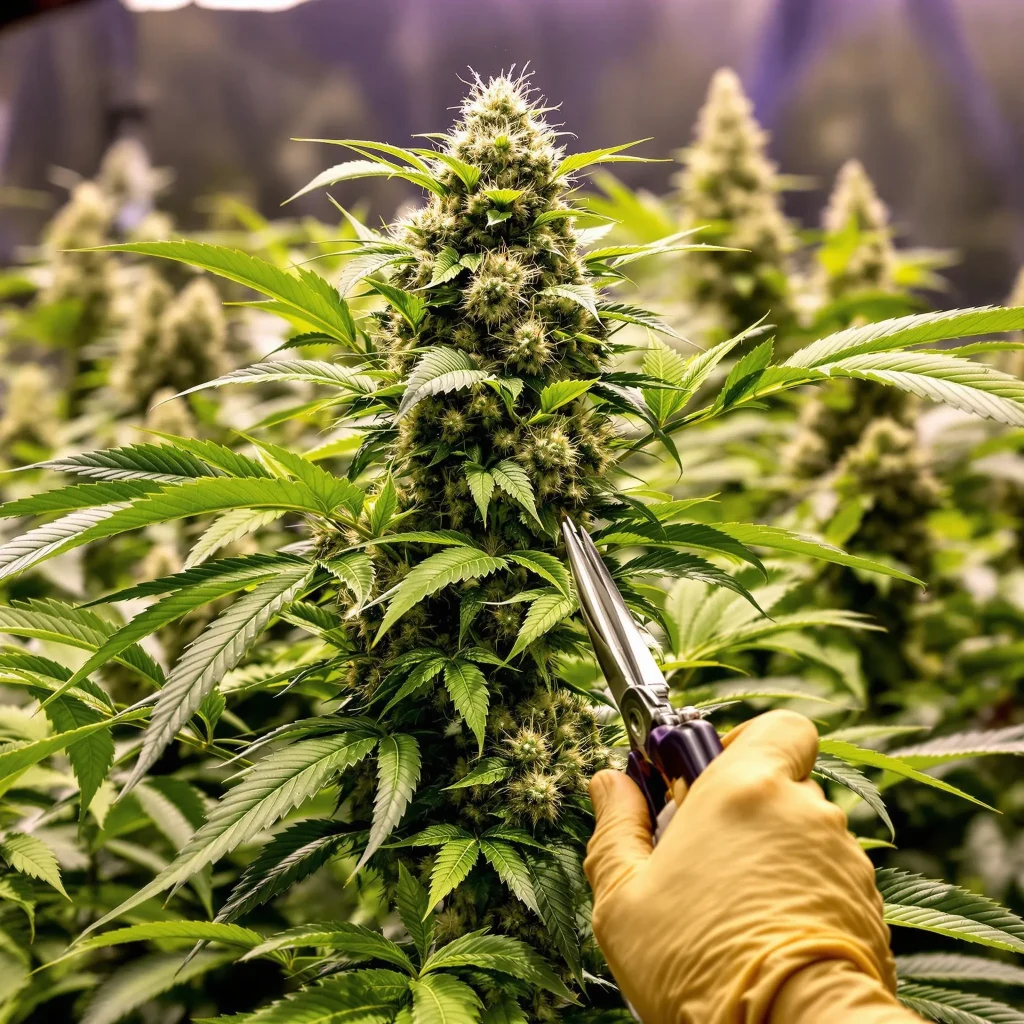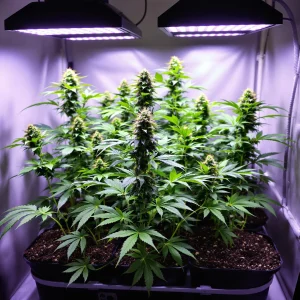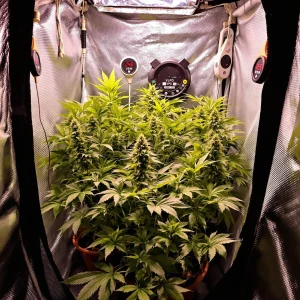What is Defoliation and Why is It Important for Autoflowers?
Defoliation in Autoflower Growth
Defoliating autoflowers late flower refers to the strategic removal of fan leaves during the plant’s final growth phase. This technique helps optimize the plant’s energy usage by focusing resources on bud production instead of maintaining excessive foliage. Autoflowering cannabis, unlike photoperiod plants, operates on a fixed lifecycle, making timely defoliation crucial for maximizing both yield and potency.
By removing obstructive leaves during late flower, growers ensure better light penetration and airflow, vital for enhancing bud density and reducing the risk of mold. This targeted pruning method supports the plant’s ability to produce resinous, high-quality flowers without causing unnecessary stress.
Differences Between Early and Late-Flower Defoliation
Early flower defoliation prioritizes shaping the plant for balanced growth and light distribution. Conversely, defoliating autoflowers late flower focuses on increasing resin production and ensuring optimal conditions for ripening buds. Timing plays a critical role here, as over-pruning during late flower can harm the plant’s health and final yield.
During late flower, it’s essential to approach defoliation cautiously. Remove only the leaves obstructing light or airflow to lower buds. This measured technique ensures your plant retains its energy-producing foliage, resulting in a more efficient growth process and resin-rich flowers.
Benefits of Defoliating Autoflowers During Late Flower
Improving Light Penetration for Dense Buds
Dense foliage can block light from reaching lower bud sites, leading to uneven development and larfy, underdeveloped buds. Defoliating autoflowers late flower eliminates this problem by ensuring even light distribution across the entire canopy. This promotes uniform bud growth and enhances the overall quality of the harvest.
Improved light penetration encourages the plant to allocate more resources toward developing dense, trichome-coated flowers. For growers aiming for a visually appealing and potent harvest, strategic defoliation is a practical solution to elevate their results significantly.
Enhancing Airflow to Prevent Mold and Mildew
Mold and mildew thrive in humid, stagnant conditions, often created by dense plant canopies. Defoliating autoflowers late flower reduces these risks by opening up the canopy, allowing better air circulation. Enhanced airflow helps regulate humidity and temperature, creating an environment where the plant can thrive without fungal threats.
Proper airflow not only protects your plants from mold but also ensures the buds remain healthy and resinous. This simple step can save growers from devastating losses while improving the quality and consistency of the final product.
Maximizing Resin Production and Potency
As autoflowers approach the end of their lifecycle, they channel energy into resin production to protect their buds. Removing unnecessary foliage during this phase helps redirect energy toward enhancing trichome development, resulting in more potent and aromatic flowers.
Defoliating autoflowers late flower is a proven technique for improving cannabinoid and terpene profiles. By encouraging the plant to concentrate its resources on resin production, growers can achieve a harvest rich in flavor, aroma, and psychoactive effects.
How to Safely Defoliate Autoflowers in Late Flower
Identifying Leaves to Remove Without Stressing the Plant
Defoliation requires precision to avoid unnecessary stress. Focus on removing fan leaves that block light from lower buds or create overlapping sections in the canopy. These areas can hinder airflow and light penetration, impacting bud development.
Yellowing or damaged leaves are the first candidates for removal. Healthy leaves should only be removed if they obstruct light or airflow. Avoid touching sugar leaves, as they are critical for resin production. This careful selection ensures minimal stress while enhancing the plant’s productivity.
Tools and Techniques for Late-Flower Defoliation
The right tools are essential for clean and efficient defoliation. Sharp, sterilized scissors or pruning shears ensure precise cuts, reducing the risk of plant injury or disease. Avoid tearing leaves by hand, as this can leave the plant vulnerable to infections.
Work methodically when defoliating autoflowers late flower. Remove one leaf at a time and step back frequently to evaluate the plant’s structure. This approach prevents over-pruning and helps maintain an open, balanced canopy, ensuring optimal conditions for growth.
Balancing Defoliation and Plant Recovery
Autoflowers have a limited recovery period due to their short lifecycle. For this reason, defoliation should be done in stages. Start by removing the most obstructive leaves and give the plant a few days to recover before making further adjustments.
This gradual approach minimizes stress while allowing the plant to redirect energy toward bud production. Balancing defoliation and recovery ensures a healthy plant and maximizes the benefits of late-flower pruning.
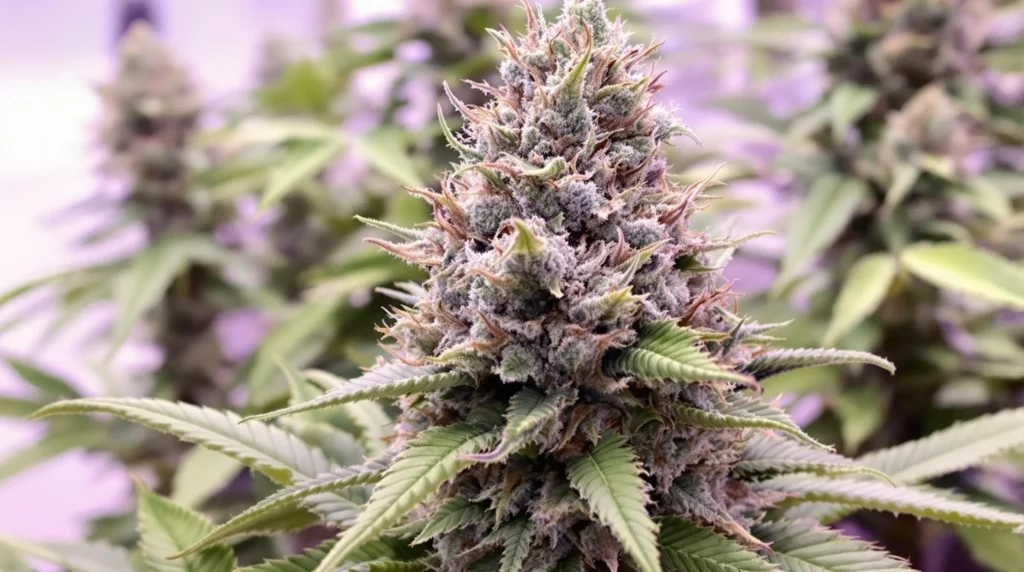
Key Tips for Successful Late-Flower Defoliation
- Start Small: If you’re new to defoliation, begin with a light pruning to observe how your plants respond.
- Monitor Plant Health: Watch for signs of stress, such as drooping leaves or slow growth.
- Focus on Foliage Blocking Light: Prioritize removing large fan leaves overshadowing lower buds.
- Maintain Hygiene: Sterilize tools before each use to prevent contamination and disease.
- Be Patient: Allow time between defoliation sessions to avoid overwhelming the plant.
By incorporating these strategies, growers can make late-flower defoliation a valuable part of their cultivation routine, optimizing both the yield and quality of their harvest.
Missteps in Late-Flower Defoliation and How to Avoid Them
Over-Defoliating and Its Impact on Yields
One of the biggest challenges when defoliating autoflowers late flower is knowing when to stop. Over-defoliating can strip the plant of its energy-producing leaves, leading to reduced yields and lower-quality buds. While it’s tempting to remove every obstructive leaf, this approach can backfire, leaving the plant struggling to finish its growth cycle.
To avoid over-pruning, focus on removing only the most problematic leaves. Remember, fan leaves play a vital role in photosynthesis, even during late flower. Keeping a balance ensures your plant remains healthy while still reaping the benefits of defoliation.
Neglecting Environmental Adjustments Post-Defoliation
After defoliation, the environment around your autoflowers changes. Increased airflow can lower humidity levels, while greater light penetration may raise the temperature at bud sites. Failing to adjust your grow room settings can undo the benefits of your efforts.
Monitor your environment closely after defoliating autoflowers late flower. Use a hygrometer to track humidity and a thermometer to ensure temperatures stay within the optimal range. Small adjustments can make a big difference in maintaining plant health and achieving the best results.
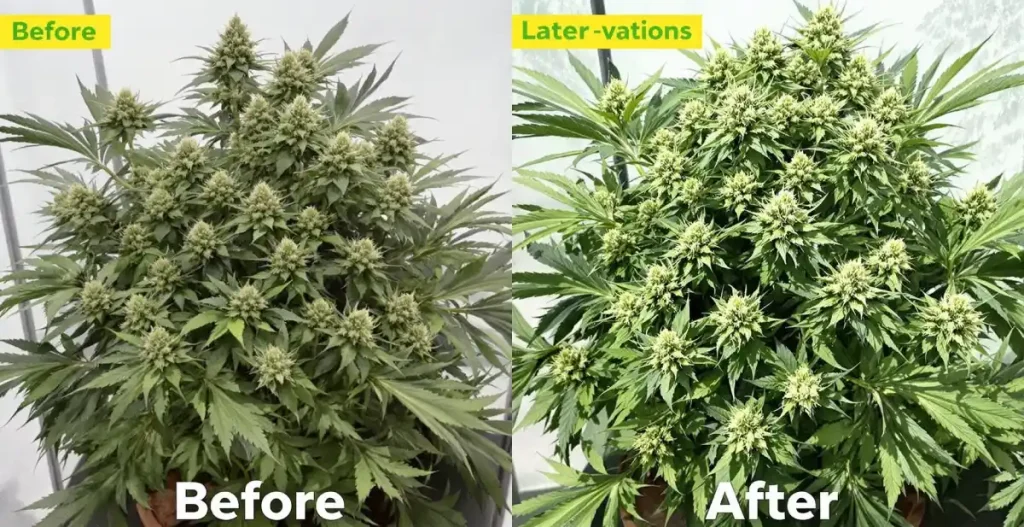
Optimized Article: Benefits of Proper Late-Flower Defoliation on Harvest Quality
Maximizing Bud Density and Size
Late-flower defoliation plays a crucial role in improving bud density and size. Removing excess foliage allows autoflowers to channel their resources into bud production rather than maintaining unnecessary leaves. This energy redistribution results in larger, denser buds with higher cannabinoid levels. Improved light penetration and airflow create ideal conditions for flower development, leading to a noticeable enhancement in quality.
Growers who prioritize defoliating autoflowers in late flower often see transformative results. A well-executed defoliation strategy can turn a standard harvest into one bursting with resin-rich, market-ready buds that command attention for their potency and visual appeal.
Streamlining the Trimming Process
Late-flower defoliation simplifies trimming, saving time and effort. By removing fan leaves before harvest, growers reduce the workload required during post-harvest manicuring. This process not only saves valuable time but also results in a cleaner, more professional-looking end product.
For cultivators aiming to sell their cannabis or enhance personal use, a well-manicured bud adds perceived value. Late-flower defoliation is a straightforward technique that ensures a streamlined trimming process and a visually appealing final product.
Improving Terpene and Flavor Profiles
Terpenes, the aromatic compounds responsible for cannabis’s distinct flavors and effects, benefit significantly from proper defoliation. Enhanced light exposure and airflow during late flower encourage higher terpene production, resulting in more flavorful and aromatic buds.
Whether you’re focused on creating concentrates or enjoying flower, terpene-rich products stand out. Growers who understand the value of defoliating autoflowers late flower consistently produce harvests with superior appeal, elevating their crops’ quality and marketability.
Top Autoflower Strains for Late-Flower Defoliation
Choosing the right strain for late-flower defoliation can significantly influence results. Some strains naturally produce dense foliage, making them excellent candidates for this technique. Below are three standout strains: Kabrales, Orange Sherbert, and Power Plant.
Kabrales: A Resin-Rich Indica
Kabrales stands out for its dense, resinous buds and robust growth. This indica-dominant strain thrives when defoliated during late flower, as better light penetration and airflow stimulate trichome production and improve overall bud quality. Its skunky aroma and rich resin make Kabrales a favorite for growers prioritizing potency and yield.
Orange Sherbert: Sweet and Fruity Hybrid
Orange Sherbert boasts a vibrant citrus flavor and balanced hybrid effects. With a bushy growth pattern, this strain benefits greatly from late-flower defoliation. Removing obstructive leaves exposes lower buds to light, ensuring uniform development and enhancing its sweet, fruity terpene profile. This makes Orange Sherbert a top choice for connoisseurs and casual consumers alike.
Power Plant: A High-Yield Sativa
Power Plant is a sativa-dominant strain celebrated for its vigor and impressive yields. Late-flower defoliation ensures that this strain reaches its full potential, with enhanced airflow preventing mold and improving bud density. Its resin-heavy flowers benefit from the added light exposure, resulting in a robust and aromatic harvest.
FAQs About Late-Flower Defoliation
Can you over-defoliate autoflowers in late flower?
Yes, excessive defoliation can stress the plant and hinder bud development. Since autoflowers have a fixed life cycle, they recover less efficiently than photoperiod strains. Remove no more than 20% of the foliage at a time, focusing on leaves that block light or restrict airflow.
Is defoliation necessary for all autoflowers?
Not all autoflowers need defoliation. Some strains naturally grow with open structures that promote airflow and light distribution. However, strains with dense foliage benefit significantly from this technique. Evaluate your plant’s structure before deciding.
When is the best time to defoliate autoflowers in late flower?
The optimal time for late-flower defoliation is two to three weeks before harvest. This timing allows the plant to redirect energy to bud production while minimizing stress. Always defoliate during the light cycle to aid recovery, and avoid defoliating in the final two weeks to maximize resin and terpene production.
What tools should I use for defoliating autoflowers?
Use sharp, sterilized scissors or pruning shears for clean cuts. Avoid tearing leaves by hand, as this increases the risk of damage and infection. Investing in quality tools ensures precise defoliation and maintains plant health.
How does late-flower defoliation impact the final product?
Proper defoliation enhances light exposure and airflow, resulting in denser, resin-rich buds. It also boosts the terpene profile, delivering a more flavorful, aromatic product. By allowing the plant to focus on essential oil production, growers achieve a harvest that stands out in quality and potency.

